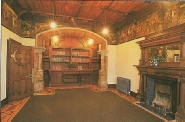Llandaff -



The growing fortunes of colliery owner, James Harvey Insole enabled him to build Insole Court in 1855. It was a modest, double-
By the early 1870s, William Burges’ work at Cardiff Castle was creating a minor sensation, not only in Cardiff, but throughout the architectural world, and those with social aspirations soon began to emulate Lord Bute’s taste.
The James Harvey Room -

The Dining Room, as it was then known, houses a beautifully painted frieze depicting ‘The Four Seasons’ by Fred Weekes, a friend of William Burges. Although similar to a frieze at Cardiff Castle, the decoration is richer and more detailed than the lighter, Italian style preferred by Lord Bute.

‘Autumn’ is painted in warm browns and reds, and ‘Winter’ shows the pleasures and pitfalls of ice-
Sadly, in the 1970’s the frieze was badly damaged by damp, and then by dry rot in the early 1990’s. Therefore, a large section of ‘Spring’ had to be recreated by restorers in 1995, but to excellent effect. Paul d’Armarda, the artist, used his daughter as the model for the little girl holding a lamb.
‘Dawn’ (the Sun God), and ‘Night’ (Moon Goddess) are depicted above the massive mahogany buffet, which sits within an archway of carved Penarth alabaster. This buffet, like Burges’ version at Cardiff Castle, is equipped with bookshelves, drawers for tobacco, cupboards and celarettes (cupboards designed to hold wine and liquor bottles, as well as wine glasses) which are decorated with gilded fittings.

The ceiling is of pitch pine, above an elaborate teak cornice, carved and pierced with foliage and gilded birds. Parrots originally peered down from the top of the buffet. The ceiling rose, a quatrefoil of gilded iron, is set with balls of coloured glass.


The teak door is mounted with gilded brass hinges and lock plates decorated with the Insole Griffin and scenes of medieval hunting.